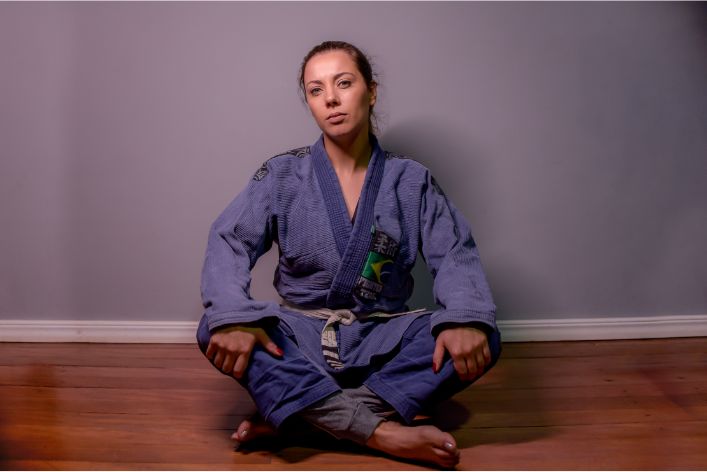Jiu Jitsu is a martial art that originated in Japan and has gained popularity worldwide. It involves grappling, submission holds, joint locks, and throws. The ranking system in Jiu Jitsu is crucial to determine the level of proficiency and skill of practitioners. This blog post aims to provide an understanding of Jiu Jitsu belts and ranking system, why it’s essential, and how it helps in the learning and development of practitioners.
The ranking system in Jiu Jitsu comprises colored belts, indicating the level of expertise and experience of practitioners. Beginner starts with a white belt, and as they progress, they can attain blue, purple, brown, and finally, a black belt, which is the highest level of proficiency. The ranking system also includes stripes on belts, which represents a level of advancement.

The ranking system is essential to ensure the standardization of techniques and skills across all Jiu Jitsu schools and practitioners. It also provides a clear path of progression and helps in promoting consistent learning and developing skills. Additionally, ranking systems provide a sense of achievement and a goal for practitioners to work towards.
The purpose of this blog post is to provide an understanding of the ranking system in Jiu Jitsu and how it works. It also aims to emphasize the importance of the ranking system in the learning and development of practitioners. By the end of this blog, readers should have a clear understanding of Jiu Jitsu belts and the ranking system.
Read: Tips for Improving Your Jiu Jitsu Game Faster
History of Jiu Jitsu Ranking System
Jiu Jitsu, which originates from Japan, is a martial art that focuses on grappling and ground fighting. It was developed by Samurai warriors in the 17th century as a self-defense mechanism. Jiu Jitsu techniques were refined over the years to become a form of sport and combat. It was introduced to Brazil in the early 1900s, where it was further developed into Brazilian Jiu Jitsu.
Traditionally, Jiu Jitsu did not have a ranking system, but rather a system of titles that indicated a practitioner’s level of mastery. These titles were awarded based on the skill level and experience of the individual. The concept of formal ranking systems was introduced around the 20th century as Jiu Jitsu began to spread around the world.
In the modern Jiu Jitsu ranking system, practitioners are identified by the color of their belts. The ranking system begins with white and ends with black, with degrees of black belt denoting higher levels of expertise. The colored belts that come before black represent different levels of proficiency and experience.
Evolution of the Ranking System
The modern Jiu Jitsu ranking system has evolved significantly since its introduction. Initially, there were only a few different levels of colored belts, but over time, additional belts were added to provide a more nuanced representation of an individual’s proficiency.
Today, depending on the academy, there are usually five to seven belts below black belt, each with its own range of ranks. For example, white belt may have four stripes, meaning four levels of proficiency before moving up to the blue belt rank.
The proliferation of belts has led to some controversy within the Jiu Jitsu community. Critics argue that the increasing number of belts creates an artificial sense of advancement and distorts the true level of skill of individual practitioners. Others believe that additional belts can motivate practitioners to continue working to improve their skills rather than becoming complacent and stagnating at a current belt level.
Despite the debate, the ranking system in Jiu Jitsu remains an essential element of the community. It provides practitioners with a clear roadmap for advancement, recognizes skill level and dedication, and allows individuals to set goals and measure their progress.
The Jiu Jitsu ranking system has come a long way since its introduction. From simple titles to advanced colored belts, the ranking system has evolved to provide a clear roadmap for advancement while recognizing practitioner’s skill levels and dedication. While the controversy around the system remains, the ranking system remains an essential component of the Jiu Jitsu community, providing a tangible way to measure skill and providing motivation for practitioners to continue pushing their own limits.
Read: The History and Evolution of Brazilian Jiu Jitsu
Understanding Belt Colors
Understanding the color of belts is crucial in making sense of the ranking system in Jiu Jitsu. Each belt color represents a specific level of mastery and expertise in the art of Jiu Jitsu.
Innovative Tech Solutions, Tailored for You
Our leading tech firm crafts custom software, web & mobile apps, designed with your unique needs in mind. Elevate your business with cutting-edge solutions no one else can offer.
Start Now#5 Explanation of White Belt
- White belt is the starting point for every practitioner of Jiu Jitsu.
- It represents the beginning of the journey towards mastering the martial art.
- White belt holders are expected to learn the basics and techniques of Jiu Jitsu.
- They are also expected to develop discipline, mental toughness, and humility.
#4 Explanation of Blue Belt
- Blue belt is the second level of mastery in Jiu Jitsu.
- It represents a significant improvement in skills and knowledge of the art.
- Blue belt holders are expected to demonstrate proficiency in basic techniques and concepts.
- They are also expected to develop their own game plan and style.
#3 Explanation of Purple Belt
- Purple belt is the third level of mastery in Jiu Jitsu.
- It represents a high level of skill and knowledge of the art.
- Purple belt holders are expected to demonstrate mastery of all basic techniques and concepts.
- They are also expected to develop their own unique game plan and style.
- They are known for their creativity and adaptability on the mat.
#2 Explanation of Brown Belt
- Brown belt is the second to the last rank before black belt in Jiu Jitsu.
- It represents exceptional skill and knowledge of the art.
- Brown belt holders are expected to display expert proficiency in all techniques and concepts of Jiu Jitsu.
- They are also expected to take on a leadership role in the Jiu Jitsu community.
#1 Explanation of Black Belt
- Black belt is the highest level of mastery in Jiu Jitsu.
- It represents complete mastery of all techniques and concepts of Jiu Jitsu.
- Black belt holders are expected to be experts in their own unique game plan and style.
- They are also expected to be role models and leaders in the Jiu Jitsu community.
- Black belt holders are known for their exceptional skill, mental toughness, and humility.
It is important to note that the journey towards achieving a black belt in Jiu Jitsu is a long and continuous process. It involves consistent training, dedication, discipline, and an open mind to learning and improving. The ranking system in Jiu Jitsu should not be viewed as a measure of superiority or competition, but rather as a recognition of one’s dedication, hard work, and contribution to the Jiu Jitsu community.
Read: How to Get Started with Jiu Jitsu: A Beginner’s Guide
Belt Promotion Criteria
1. Time-based promotion criteria:
- The student must have trained for a specific timeframe before being eligible for promotion.
- The minimum required training time varies according to the student’s age and belt level.
- For example, a student who is under 16 years old and holds a white belt must train for at least 2 years before being eligible for promotion to blue belt.
2. Skill-based promotion criteria:
- The student must demonstrate proficiency in the techniques and principles of Jiu Jitsu.
- The instructor evaluates the student’s technique, timing, efficiency, control, and composure during regular training and sparring sessions.
- The student must also display adaptability, creativity, and an understanding of strategy.
3. Competition-based promotion criteria:
- The student must participate in competitions to demonstrate their skills and abilities.
- The instructor evaluates the student’s results, performance, and attitude during the competition season.
- The student must also adhere to the rules and values of sportsmanship and respect towards opponents, referees, and spectators.
4. Contribution-based promotion criteria:
- The student must contribute to the development and growth of Jiu Jitsu in their community.
- The instructor evaluates the student’s participation in teaching, assisting, organizing, and promoting Jiu Jitsu events and activities.
- The student must also demonstrate a positive attitude, teamwork, and leadership skills.
Belt promotion criteria in Jiu Jitsu are comprehensive, aiming to ensure students master techniques and uphold the sport’s values. The criteria underscore the importance of discipline, dedication, and consistency.
Skill-based criteria emphasize the need for technical proficiency and creativity. Competition-based criteria highlight sportsmanship, respect, and competitiveness. Contribution-based criteria stress community building, leadership, and service.
Promotion criteria vary among Jiu Jitsu schools, associations, and lineages. Schools may prioritize specific criteria based on their values. Criteria may adjust according to a student’s age, physical condition, health, and personal circumstances. However, promotion criteria should always be clear, consistent, transparent, and communicated to students beforehand.
The belt promotion ceremony marks a key milestone, rewarding a student’s hard work, progress, and commitment. The ceremony boosts the student’s motivation to keep learning and growing. It usually includes a public demonstration, an instructor’s speech, the presentation of the new belt, and community congratulations.
In summary, the belt isn’t Jiu Jitsu’s ultimate goal. It symbolizes a student’s progress and potential. Regardless of belt color or rank, a student should train with humility, respect, and curiosity. They should also connect with the Jiu Jitsu community, learn from others, and contribute to the sport’s future growth.
Read: Sumo Wrestling’s Impact on Japanese Culture
Benefits of Belt Ranking System in Jiu Jitsu
The belt ranking system is an essential aspect of Brazilian Jiu Jitsu. It represents the progression of a student’s skills and knowledge in the art. The system provides several benefits to both the student and the school, such as:
Discipline and Focus
- It helps instill discipline and focus in students as they strive to achieve the next belt level.
- Knowing that they have to put in the necessary effort and hard work to progress creates a disciplined mindset and sense of purpose.
Goal-setting and Motivation
- It provides a clear-cut and attainable goal that students work toward, which motivates them to continue learning and training.
- Having a clear goal allows students to stay focused and results in a greater feeling of accomplishment when they reach their goal.
Skill Evaluation and Progress Tracking
- The ranking system allows students and instructors to evaluate skill levels and track progress objectively.
- Regular testing and evaluations provide feedback on areas that need improvement so that students can refine their techniques and knowledge.
Standardization and Credibility
- The belt ranking system creates a standardization of skill level that is recognized and respected by the wider Jiu Jitsu community.
- It provides a credible and recognized system of certification that verifies a student’s skill level and knowledge.
The benefits of the belt ranking system in Jiu Jitsu extend beyond just the individual student. It creates an environment of discipline, motivation, and standardization that is essential for the growth and progression of the art. As students earn belts and progress through the ranks, they become leaders and role models to others, inspiring them to keep working and striving to reach their goals.
Read: What are the Basic Rules of Sumo Wrestling?
Misconceptions About Belt Ranking System
When it comes to Jiu Jitsu and the art of grappling, there are always misconceptions surrounding the belt ranking system. Here are some common falsehoods about the ranking system of Jiu Jitsu:
1. Belts do not guarantee proficiency
One of the most common misconceptions about Jiu Jitsu ranking system is that the higher the belt, the more proficient the practitioner. However, a belt color is only a symbolic representation of a practitioner’s skills, knowledge, and experience. A black belt holder does not automatically mean they are invincible and all-powerful fighters.
2. Belts do not define the worth of a practitioner
Another misconception about the ranking system is that wearing a particular belt gives a practitioner a higher sense of value and respect than others. A belt ranking does not equal to an individual’s intrinsic worth or martial arts abilities. Practicing Jiu Jitsu is a pathway to individual development, and each practitioner grows at their own pace.
3. Higher-ranked practitioners do not always win
Believing that higher-ranked practitioners always win is a common misconception. Each Jiu Jitsu practitioner has their own unique skills and specialties that can be advantageous during a match. Some lower-ranked students have exceptional techniques that can win over higher-ranked opponents.
To sum up, the belt ranking system of Jiu Jitsu is a form of acknowledgement for a practitioner’s progress in the art. It is a guide to help students understand their growth, but it does not define a practitioner’s martial arts abilities or worth. In Jiu Jitsu, the journey is more critical than the destination, and each student grows at their pace and style.
Read: How to Train Like a Sumo Wrestler: Tips & Techniques
Conclusion
To become a proficient Jiu Jitsu practitioner, it is crucial to understand the significance of the ranking system. A clear comprehension of Jiu Jitsu belts can help you set realistic goals and track your progress over time. The ranking system also creates a sense of community and camaraderie among practitioners of different levels.
However, it is important to remember that progress should not solely be measured by promotions. Instead, one should strive to continuously improve their skills and knowledge, regardless of their rank. By setting goals and consistently working towards them, you can make significant advancements in your Jiu Jitsu journey.
Therefore, as a call to action for all Jiu Jitsu practitioners, let us focus on progressing our skills and abilities rather than just aiming for the next belt. By prioritizing development over promotion, we can achieve a greater sense of gratification and accomplishment in our martial arts journey.
Read: Understanding Sumo Wrestling Ranking System
Before You Go…
Hey, thank you for reading this blog to the end. I hope it was helpful. Let me tell you a little bit about Nicholas Idoko Technologies. We help businesses and companies build an online presence by developing web, mobile, desktop, and blockchain applications.
We also help aspiring software developers and programmers learn the skills they need to have a successful career. Take your first step to becoming a programming boss by joining our Learn To Code academy today!
Be sure to contact us if you need more information or have any questions! We are readily available.
Seamless API Connectivity for Next-Level Integration
Unlock limitless possibilities by connecting your systems with a custom API built to perform flawlessly. Stand apart with our solutions that others simply can’t offer.
Get Started









